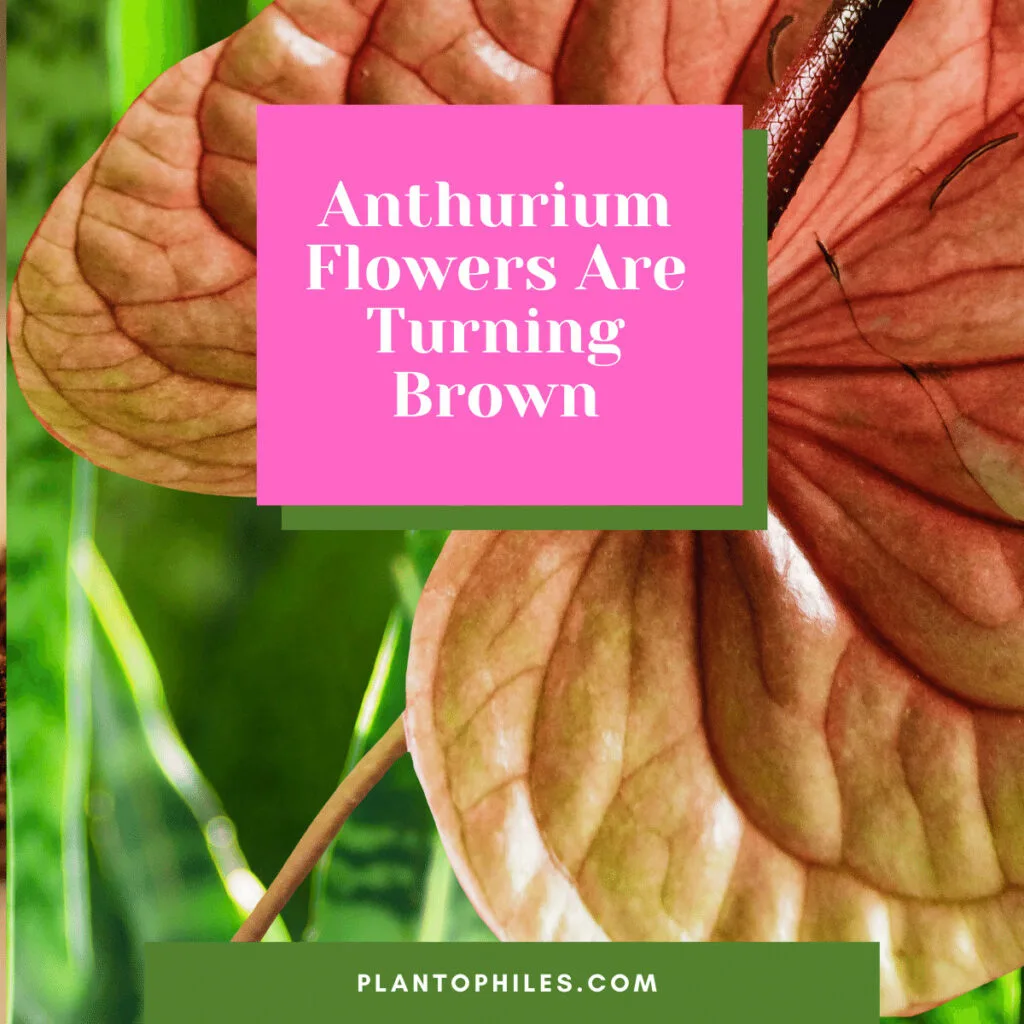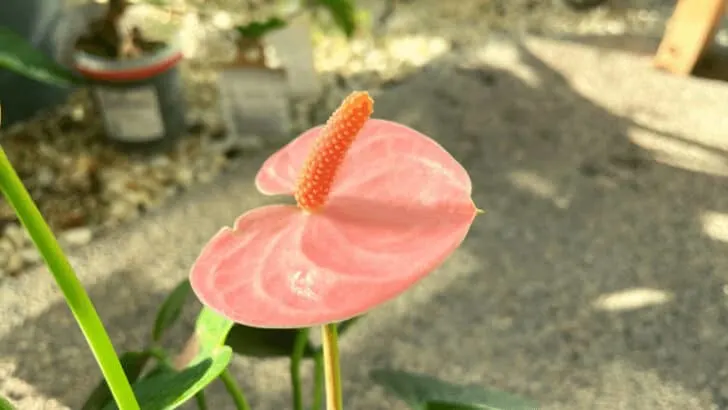Anthurium flowers are turning brown for several reasons. The most common reasons are a natural cause, over- or underwatering, overfertilization, nutrient deficiency, incorrect humidity, too much sunlight, cold stress, and pests.
Flamingo flowers are beautiful and long-lasting on a healthy Anthurium. They can flower multiple times yearly, and the blooms last for weeks before dying as part of natural aging.
Table of Contents
Anthurium Flowers Are Turning Brown
Anthurium flowers are turning brown for the following reasons:
- natural cause
- overwatering
- underwatering
- overfertilization
- nutrient deficiency
- incorrect humidity
- too much sunlight
- cold stress
- pests
- fungus
- repotting

11 Reasons Why Anthurium Plant Flowers Are Turning Brown
1. Natural cause
Anthuriums flower for about six weeks, according to the University of Florida. The Anthurium flowers throughout the year, usually with 3-6 flowers at a time.
Once the flowers finish blooming, they turn brown and fall off. So flowers turning brown can have a natural cause.
Remedy: As this is a natural cause, it cannot be remedied. Accept it and make sure you are providing the correct amount of water, nutrients, water, humidity, and temperature.
2. Overwatering
Overwatering is one of the most common reasons Anthurium plants lose their blooms. These plants should be watered once every seven days once the soil is dry.
Watering more often or when the soil is still humid can lead to root rot and blooms turning brown.
Remedy: Water your Anthurium only when the soil is dry to the touch. Use your index finger and put it into the soil. If the top 1-2 inches of soil (2.5-5 cm) are dry, it is time to water. If your plant is already affected, remove it from the pot and remove all the soil. Remove rotting roots using pruning shears. Prune off all the mushy roots. Wash the healthy roots under lukewarm water. Disinfect the pot and exchange the plant soil.
3. Underwatering
If you do not adhere to a frequent watering schedule or miss the perfect time when the soil becomes dry, it can adversely affect your plant.
Anthuriums may start to will and lose their flowers. This will start with saggy leaves, stems, flowers, and browning.
Remedy: Stick to a consistent watering schedule. E.g., water every seven days on the same day and use your index finger in-between to check the soil humidity. Water if the soil is dry, even if the seven days are not up.
4. Overfertilization
Fertilize in spring and summer during the main growing seasons. The ideal frequency is about once a month using a balanced liquid fertilizer.
Use 1/2 to 1/3 of the recommended strength on the package, and do not overfertilize. Overfertilization can result in root burn and brown flowers.
Remedy: Follow the instruction on the leaflet. If you added too much fertilizer, get the plant out of the pot. Remove the potting soil. Clean the roots under lukewarm water. Exchange the soil with a new potting mix.
5. Nutrient deficiency
If plants do not have enough fertilizer, they might not have sufficient energy to produce new leaves and flowers. In addition, the flowering process might be stopped or aborted.
Remedy: Fertilize your Anthurium once a month in spring and summer using a balanced NPK fertilizer of 20-20-20 or 10-10-10 (nitrogen (N), phosphorous (P), and potassium (K)).
6. Incorrect humidity
Anthuriums love high humidity between 70-80%. Although they tolerate lower humidity, they might not thrive at low levels. A humidity of 40% or less can have negative effects on these Aroid plants.
Remedy: Put plants closely together and use a pebble tray underneath the plant to increase indoor humidity for these houseplants.
7. Too much sunlight
Bright indirect light is best for this indoor plant. It can take direct sunlight for no longer than 4 hours a day.
If direct sunlight falls on the leaves for more than 4 hours a day, it might burn and scorch the foliage and the flowers. This will result in sunburn. Tropical plants often grow under plant canopy.
Remedy: The ideal placement is in an eastern or western-facing window. These get full sun in the morning or afternoon and indirect light during the rest of the day.
8. Cold stress
The ideal temperature for Anthuriums is 77-92°F (25-32°C). Evening and night temperatures can be lower at about 70-75°F (21-24°C).
Once temperatures fall below 50 degrees Fahrenheit ( 10 degrees Celsius), it will damage the leaves, blooms, and the plant itself.
Remedy: Ensure your plant is some distance away from a window in winter (5-10 inches or 12.7 – 25.4 cm). Avoid cold drafts and take plants indoors in autumn once the temperatures get colder.
9. Pests
The most common pests that invade Anthurium are mealybugs, thrips, spider mites, scales, gnats, and white flies.
These insects often suck plant sap and will cause distorted growth, and leaves turn yellow and brown. In addition, black spots and wilting foliage and flowers are the results.
Remedy: Check your Flamingo flower once a week for pests. Look at the underside of the leaves and also inspect the soil. As a preventative measure, use Neem oil or a combination of dishwater soap and rubbing alcohol diluted in water. Spray your plants weekly.
10. Fungus
The Flamingo flower is susceptible to fungus and bacteria, according to the University of the West Indies.
One of these bacterial issues is bacterial blight caused by Xanthomonas campestris pv. dieffenbachiae. The issue is caused by constant high humidity, insufficient airflow, and water building up and remaining on the leaves. It can lead to bronzed blooms and spreads quickly.
Remedy: Allow for sufficient airflow. Make use of a ventilator. In addition, do not spray your plants using a spraying bottle, as the water drops might stay on the foliage for too long.
11. Repotting
Never repot when your plants are in bloom. Repotting during this time stresses the plants and can lead to abandoned flowers. The flowers will turn brown and fall off the plant.
Remedy: The ideal season to repot a plant is a spring and summer. Anthuriums usually flower for three months straight and then don’t flower anymore for three months. Repot when they are not in bloom in spring or summer.
Anthurium leaves turn brown
An Anthurium has brown leaves for the same reason flowers may turn brown. The cause of brown leaves are underwatering, overwatering, pests, overfertilization, and so on.
Green leaves and bright bracts are the anthurium’s signature look. The plant’s health might be at risk if that is not the case, as flowers and leaves will indicate plant problems early on. Help your plant recover by detecting infestations early and correcting overfertilizing, bacterial infections, etc.
Read more about why Anthurium leaves turn brown in this article.
Should You Leave Brown Anthurium Flowers?
Brown Anthurium flowers can be taken off the plant using a pruning shear, scissors, or a knife. You can also snip them off by hand. Once the flowers are brown, they have already moved the remaining nutrients back to the plant. The brown flower cannot turn back and cannot be saved.
Why Does Your Anthurium have Brown Spots on Flowers?
Brown spots on the flowers are often caused by bacterial and fungal growth, such as Bacterial blight Xanthomonas lesions. Cut-off infected flowers as bacterial and fungal infections spread quickly. Reduce the humidity and ensure no water drops are assimilating into the foliage or flowers.
Why Are My Anthurium Flowers Green?
Green Anthurium flowers are a sign that your plant gets insufficient light. Cut off the green flowers, as your plant will spend a lot of energy on non-producing flowers. Move your plant into bright indirect light. An eastern- or western-facing window is ideal.
Frequently Asked Questions
How Long Do Anthuriums Blooms?
Anthurium blooms can last up to six weeks. They are usually 4-6 blooms on each plant, and the plant will flower throughout the year. It will usually alternate between 3 months with blooms and three months without blooms.
Should Anthurium Flowers Be Red?
There are many different Anthurium flower colors, such as pink, yellow, creme, and yellow. So not all Flamingo flowers will produce red blooms. Also, what most refer to as blooms are bracts. Bracts are modified leaves. The flower itself consists of a spathe and spadix and is at the center of the bract.
What If You’re Not Getting Many Blooms On An Anthurium?
If your Anthurium plant produces a few blooms only, it can mean that it is not big enough yet or that it does not get sufficient light, fertilizer, or water. Fertilize monthly, water once a week, and provide bright indirect light to remedy this situation.
Should I Cut Off Dead Anthurium Flowers?
Spent brown Anthurium flowers should be cut off. Brown leaves and flowers can host plant pests, so it is best to discard them as soon as possible.
Why are the flowers on my Anthurium dying?
Anthurium flowers will turn brown because of a natural cause, overwatering, underwatering, overfertilization, nutrient deficiency, incorrect humidity, too much sunlight, cold stress, pests, fungus, or repotting.

Daniel has been a plant enthusiast for over 20 years. He owns hundreds of houseplants and prepares for the chili growing seasons yearly with great anticipation. His favorite plants are plant species in the Araceae family, such as Monstera, Philodendron, and Anthurium. He also loves gardening and is growing hot peppers, tomatoes, and many more vegetables.


